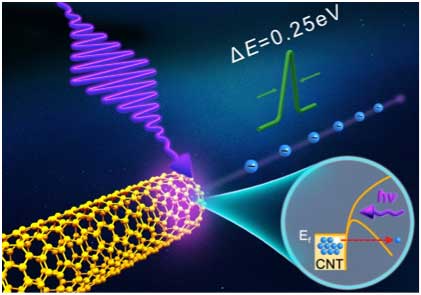| Posted: Jan 02, 2018 |
Carbon nanotube as ultrafast emitter with narrow energy spread at optical frequency
(Nanowerk News) Ultrafast Electron Microscopy (UEM), or more widely termed, 4D Electron Microscopy, pioneered by the Nobel Laureate Prof. Ahmed Zeweil of the California Institute of Technology, provides an unprecedented means of interrogating ultra-fast physical and chemical processes, critical for the deeper understanding of various fundamental processes in optics, electronics, condensed-matter physics, chemistry, biology, and surface science.
|
|
Such 4D electron microscopes are widely recognized as a means of revolutionizing traditional characterization techniques should the spatial and temporal resolution concurrently reach the challenging angstrom and attosecond scales.
|
|
This requires two, yet to be achieved, properties from the probing electron beam. In compromising the narrow energy spread, current state-of-the-art UEMs employ optically-driven sources, which afford simple, yet comparatively poor temporal resolution.
|
|
In recent work published in Advanced Materials ("Carbon Nanotubes as an Ultrafast Emitter with a Narrow Energy Spread at Optical Frequency"), Prof. Qing Dai and his team of the National Center for Nanoscience and Technology, China, alongside Prof. Kaihui Liu from Peking University, and Prof. Zhipei Sun from Aalto University, have successfully demonstrated exciting findings on the realization of field-driven ultrafast photo electron emission, in a system capable of much higher phase synchronization than its photon-driven counterpart.
|
|
Using carbon nanotubes (CNTs), energy spreads as low as 0.25 eV have been achieved for the first time. This leading performance has been realized through optical sub-cycle electron tunneling excited by the shortest optical wavelength to date, only made possible through the team’s unique expertise in nanoengineering, and in particular their structuring of unique CNT surfaces.
|
|
These nano surfaces afford high field enhancement and high structural stability and have much potential as a new generation of ultrafast electron sources in microscopy and spectroscopy.
|
 |
|
Prof. Qing Dai commented; “our results are of significant importance, both scientifically and technologically, towards the next generation of attosecond science and light-wave electronics research”.
|
|
The research is the first demonstration of its kind on field-driven ultrafast photoemission from self-assembled nanostructures. The CNTs used enable the production of highly coherent, low energy spread electron sources that are at least one order of magnitude improved over incumbent stat-of-the-art optical field-driven ultrafast electron sources and twice improved over current photon-driven sources.
|
|
The team couple their skills of material manipulation at the atomic scale to allow them to exploit, for the first time, photoemission at a wavelength of only 410 nm; a readily-accessible and comparatively inexpensive optical window that has yet to been exploited with traditional metallic microstructures.
|
|
The authors are confident that field-driven photoemission at even shorter pump wavelengths is likely in the near future, which they believe will reshape our understanding of strong field physics, and may very well light the way for entirely new types of electron emission systems.
|

